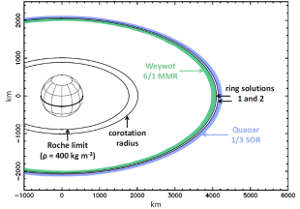Using AI to control energy for indoor agriculture
30 September 2024
Published online 9 February 2023
The unexpected position of a ring around the dwarf planet Quaoar demands a rethink of orbital dynamics.

Morgado, B.E., et al. Nature (2023).
Enlarge image
Using data from the European Space Agency’s CHEOPS mission, an international team of astronomers has detected a ring around the Kuiper Belt dwarf planet Quaoar that appears to defy what we know about orbital dynamics. The ring exists at a distance 7.5 times Quaoar’s radius, where theory predicts it should have stuck together, forming a moon.
Quaoar is only 555 kilometres in radius and is orbited by an 80-kilometre-radius moon called Weywot. Such small, distant objects cannot be observed directly, and require a technique called stellar occultation – measuring tiny changes in the light from distant stars as the small bodies pass in front of it.
“We observed occultations of different stars between 2018 and 2021,” says Bruno Morgado at the Federal University of Rio de Janeiro in Brazil, who was lead author of the team’s paper, published in Nature. “This technique is very sensitive to the presence of material around the occulting bodies, and we were able to detect a ring around Quaoar. The ring is not where it is supposed to be!”
Specifically, the dense, irregularly shaped ring exists outside a theoretical radius called the Roche limit.
“Inside the Roche limit, the gravitational forces are so intense that they are able to break a satellite into small pieces, becoming a ring,” says Morgado. “Outside the limit, a ring will rapidly accrete and become a satellite.”
The team suggests that the ring’s unexpected position is best explained by resonances related to the spin and orbital motion of Quaoar and Weywot. Such small bodies are likely to have asymmetric shapes that enhance such resonances.
“For the ring to be stable we need something to increase the dispersion velocities of the particles that make it up,” explains Morgado. “Resonances is a good guess, and the Quaoar Ring is near the regions of two interesting resonances, one with Weywot and one with Quaoar itself.” Importantly, this implies that the classical notion of the Roche limit should be revised for small planetary bodies.
Collecting enough data to examine Quaoar’s ring was only possible through a global effort, including researchers in the Middle East. Morgado explains: “The stellar occultations can happen at any given time and their shadows cross many different places on Earth. The 2019 occultation presented in the project crossed Morocco, where Zouhair Benkhaldoun at Cadi Ayyad University in Marrakech observed the event and shared data with us.”
Larry Esposito, an expert in planetary atmospheres and rings at the University of Colorado in Boulder, US, who was not involved in the Quaoar study, notes the significance of finding a ring that has formed so far away from its parent object without collecting into a moon.
“Quaoar’s ring may be an extreme case of Saturn’s ‘F’ ring, known to be patchy, where the gravity of nearby moons stirs the ring, triggers growth of large bodies and propels the ring particles to high speeds,” Esposito suggests.
doi:10.1038/nmiddleeast.2023.12
Morgado, B.E. et al. A dense ring of the trans-Neptunian object Quaoar outside its Roche limit. Nature https://doi.org/10.1038/s41586-022-05629-6 (2023).
Stay connected: